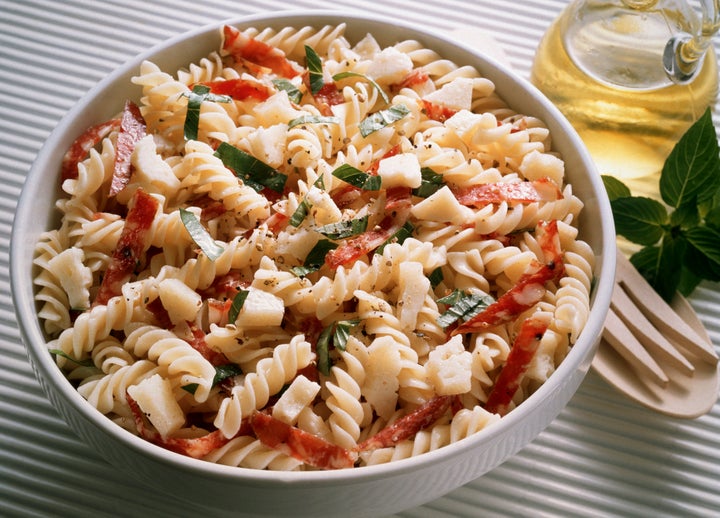
We’ve all had it. The pasta salad that looks so colorful on the picnic table, but turns out to be a sloppy mess. The pasta is mushy, the veggies are limp, and now you’re wishing for a dog to discreetly feed under the table.
It doesn’t have to be this way. Years ago, I created recipes as the head chef in a deli, where we made every kind of cold food for the case. Before we opened, I’d check the salads we’d made the day before, and jhuzh them a bit.
I still have an involuntary twitch when I taste a soggy pasta salad, so I’m here to help you avoid some common pitfalls.
Get The Pasta Right
If you’re one of those people who says “pasta is pasta, buy the cheap one,” I’m here to tell you, it’s not. Especially in pasta salads, where you’re asking the pasta to sit in an acidic bath for hours.
Mediterranean-inspired pasta salads are usually made from short, dried pastas, like penne, shells, farfalle or fusilli. Don’t waste fresh pasta on pasta salad, because it won’t hold up.
Top brands
DeCecco, Barilla, Rao’s, DeLallo and other brands made from durum semolina wheat are your best bet. The best brands use coarsely ground semolina flour and press it through bronze dies, which give it a slightly rougher texture than the Teflon-coated dies used in lower-quality pasta.
Cook it properly
The tried and true method of cooking pasta, but with more salt than usual, is your best bet. For a pound of pasta, boil a gallon of water and the usual tablespoon of salt, plus a teaspoon or so, to really season your pasta. Chilling will mute all the flavours, including the salt.
Drop in the pasta, stir it every few minutes to keep it from sticking or cooking unevenly, and set a timer for a minute less than the package directs. Then test it.
Al dente, but not too al dente
Cooking pasta that will be chilled has its own pitfalls. When testing your pasta, rinse a piece with cold water to completely cool it before taking that crucial bite.
I learned early on in my chef life that starches, whether in potatoes, rice or pasta, can become firmer when they are cooked and chilled.
Andrew Ross, a cereal chemist and professor of crop and soil science at Oregon State University, gave me the lowdown on why: “All starchy foods will feel tender to the bite while hot, but can become firmer when cold. It is starch recrystallisation, or retrogradation. The starch molecules start to bond together as the food cools, creating a stronger matrix.”
That means you should cook the pasta just past firm, but not flabby.
How To Marinate It
The best practice is to prep the dressing, chop the vegetables, and cook the pasta as close to when it will be eaten as you can. Drain the pasta and rinse it with warm water, not cold, then shake the pasta to drain it well. While it’s still warm, not hot, dress the pasta with half of the dressing, then stir in the remaining just before serving.
Adding part of the dressing while the pasta is warm helps it bind to the pasta and sink in just a little. If you’re making the pasta salad a day ahead, pile the veggies on one side of the container and the dressed pasta on the other, and toss to combine at the last minute.
Back at the deli, tasting the pasta twice a day revealed how the bright flavours became muted, as the pasta absorbed the liquids and everything oxidised. A quick jolt of the same dressing, or a mix of the oil, acid and a little salt will freshen it up.
Creamy dressings
Mayo, sour cream and other creamy ingredients will also soak into the pasta as it sits. After a day or two in the fridge, make sure you stir the mixture well to recoat the pasta with any dressing and the liquids from your veggies that have puddled at the bottom, and brighten the flavours with a bit of acid and salt.
Never add these ingredients
Thinking of adding some black beans, walnuts or other dark foods? Add them just before serving, or the noodles nestled next to them in the fridge will absorb the pigments, tattooing the pasta with dark spots. And hold off on adding soft cheese and delicate greens until just before serving, because both are destroyed by a soak in acidic dressing.
Consider whole grains, which are indestructible
If you want a hearty salad that will improve with time, make a whole grain salad. The same flavours you love in a pasta salad also complement cooked farro, whole oat groats, wild rice or other whole grains. As the grains soak in the dressing, they become more tender and flavourful, in a good way. A farro salad can sit for four or five days in the fridge with no loss of texture, and a little jhuzh with dressing is all you need.